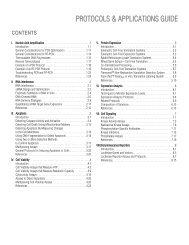Cloning Protocols and Applications Guide-A4 format - Promega
Cloning Protocols and Applications Guide-A4 format - Promega
Cloning Protocols and Applications Guide-A4 format - Promega
You also want an ePaper? Increase the reach of your titles
YUMPU automatically turns print PDFs into web optimized ePapers that Google loves.
||||||||||||| 13<strong>Cloning</strong><br />
Analysis<br />
Materials Required:<br />
(see Composition of Solutions section)<br />
• aliquot of amplification reaction (usually 5–10µl)<br />
• Optional: Blue/Orange Loading Dye, 6X (Cat.# G1881)<br />
if GoTaq® Green Reaction Buffer is not used<br />
• appropriately sized DNA marker<br />
• appropriate agarose gel (typically 0.8–1.2%; see Table<br />
13.1 for guidelines)<br />
• gel running buffer (1X TAE or 0.5X TBE)<br />
• 10mg/ml ethidium bromide<br />
1. Analyze 5–10µl of the amplification reaction using<br />
agarose gel electrophoresis. Include at least one lane<br />
containing a DNA size marker to determine if the PCR<br />
products are of the correct size. The products should<br />
be readily visible by UV transillumination of the<br />
ethidium bromide-stained gel (50µg/ml final<br />
concentration in the agarose).<br />
2. Store reaction products at –20°C until needed.<br />
Table 13.1. Gel Percentages: Resolution of Linear DNA<br />
on Agarose Gels.<br />
Recommended %<br />
Optimum Resolution<br />
Agarose<br />
for Linear DNA<br />
0.5<br />
1,000–30,000bp<br />
0.7<br />
800–12,000bp<br />
1.0<br />
500–10,000bp<br />
1.2<br />
400–7,000bp<br />
1.5<br />
200–3,000bp<br />
2.0<br />
50–2,000bp<br />
If there are primer dimers or at least two PCR products<br />
present, the b<strong>and</strong> of interest will need to be excised <strong>and</strong><br />
purified (see the next section, PCR Cleanup, for more<br />
in<strong>format</strong>ion). To minimize the number of extraneous<br />
amplimers, the PCR conditions may need to be optimized.<br />
For suggestions on troubleshooting PCR, visit the PCR<br />
Amplification chapter of the <strong>Protocols</strong> <strong>and</strong> <strong>Applications</strong> <strong>Guide</strong><br />
.<br />
PCR Cleanup<br />
Once you have determined that the PCR was successful,<br />
you can purify the desired product from the rest of the<br />
reaction components. This can be accomplished using a<br />
number of procedures including direct purification of the<br />
product using the Wizard® SV Gel <strong>and</strong> PCR Clean-Up<br />
System (Cat.# A9281, A9282, A9285) or separating the DNA<br />
fragments on an agarose gel. Alternatively, you can use a<br />
portion of the amplification reaction directly in a ligation.<br />
However, the presence of primer dimers or other amplimers<br />
present can cause false-positive reactions or yield an<br />
incorrect clone (see Figure 13.8). If the reaction is clean (i.e.,<br />
a single b<strong>and</strong> is seen on an analytical gel), <strong>and</strong> the desired<br />
product is a minimum of 100bp in size, you can use the<br />
Wizard® SV Gel <strong>and</strong> PCR Clean-Up System to directly<br />
purify the PCR product [see the DNA Purification chapter<br />
of the <strong>Protocols</strong> <strong>and</strong> <strong>Applications</strong> <strong>Guide</strong> for product protocol].<br />
<strong>Protocols</strong> & <strong>Applications</strong> <strong>Guide</strong><br />
www.promega.com<br />
rev. 1/12<br />
If there are other b<strong>and</strong>s or a large primer-dimer b<strong>and</strong><br />
present, we recommend gel electrophoresis to separate the<br />
products so that the desired b<strong>and</strong> can be excised. The DNA<br />
can be recovered by melting the excised agarose <strong>and</strong> using<br />
the Wizard® SV Gel <strong>and</strong> PCR Clean-Up System.<br />
Figure 13.8. Purification of PCR products enhances cloning<br />
success. A 500bp PCR product was purified with the Wizard® SV<br />
Gel <strong>and</strong> PCR Clean-Up System <strong>and</strong> cloned into the pGEM®-T Easy<br />
Vector. Both the percent recombinants <strong>and</strong> total number of colonies<br />
increased with a pure PCR product.<br />
Optional: A-Tailing Reaction for Blunt-Ended Products:<br />
If a proofreading DNA polymerase was used for<br />
amplification <strong>and</strong> you want to clone into a T vector, an<br />
adenosine residue must be added to the PCR product. This<br />
can be accomplished by incubating the DNA fragment with<br />
dATP <strong>and</strong> a nonproofreading DNA polymerase, which will<br />
add a single 3′ A residue. Blunt DNA fragments resulting<br />
from restriction enzyme digestion also can be cloned into<br />
T vector after adding an adenosine residue.<br />
Materials Required:<br />
• blunt-ended product (from PCR or restriction enzyme<br />
digestion), purified<br />
• GoTaq® Flexi DNA Polymerase<br />
• 25mM MgCl2<br />
• 5X GoTaq® Colorless or Green Reaction Buffer<br />
• 1mM dATP (Cat.# U1205; diluted 1:100 in nuclease-free<br />
water)<br />
1. Set up the following reaction in a thin-walled PCR tube:<br />
Purified DNA fragment<br />
5X GoTaq® Reaction Buffer (Colorless or<br />
Green)<br />
1mM dATP (0.2mM final concentration)<br />
GoTaq® Flexi DNA Polymerase (5u/µl)<br />
25mM MgCl2 (1.5mM final concentration)<br />
Nuclease-free water to<br />
1–4.4µl<br />
2µl<br />
2µl<br />
1µl<br />
0.6µl<br />
10µl<br />
2. Incubate at 70°C for 15–30 minutes in a water bath or<br />
thermal cycler. After the tailing reaction is finished,<br />
1–2µl can be used without further cleanup for ligation<br />
with pGEM®-T or pGEM®-T Easy Vector Systems.<br />
PROTOCOLS & APPLICATIONS GUIDE 13-12

















